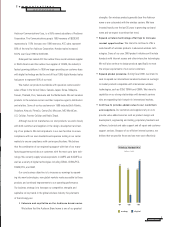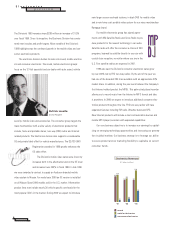Audiovox 1999 Annual Report Download - page 19
Download and view the complete annual report
Please find page 19 of the 1999 Audiovox annual report below. You can navigate through the pages in the report by either clicking on the pages listed below, or by using the keyword search tool below to find specific information within the annual report.
17
AUDIOVOX
Seasonality
The Company typically experiences some seasonality in its opera-
tions. The Company generally experiences a substantial amount of its
sales during September, October and November. December is also a key
month for the Company due to increased demand for its products during
the holiday season. This increase results from increased promotional and
advertising activities from the Company’s customers to end-users.
Year 2000 Date Compliance
The Company is not aware of any year 2000 issues that have affected
its business. In preparation for the year 2000, the Company incurred inter-
nal staff costs as well as consulting and other expenses. Year 2000
expenses totaled less than $1 million. These expenses were not signifi-
cant because, during 1996, the Company replaced or updated a significant
portion of its computer systems, both hardware and software, with year
2000 compliant systems.
It is possible that the Company’s computerized systems could be
affected in the future by the year 2000 issue. The Company has numerous
computerized interfaces with third parties that are possibly vulnerable to
failure if those third parties have not adequately addressed their year
2000 issues. System failures resulting from these issues could cause sig-
nificant disruption to the Company’s operations.
Recent Accounting Pronouncements
The Financial Accounting Standards Board (FASB) issued Statement
137, “Accounting for Derivative Instruments and Hedging Activities—
Deferral of the Effective Date of FASB Statement No. 133.” Statement
137 amends Statement 133, “Accounting for Derivative Instruments and
Hedging Activities,” which was issued in June 1998 and was to be effec-
tive for all fiscal quarters of fiscal years beginning after June 15, 1999.
Statement 137 defers the effective date of Statement 133 to all fiscal
quarters of fiscal years beginning after June 15, 2000. Earlier application
is permitted. Statement 133 establishes accounting and reporting stan-
dards for derivative instruments, including certain derivative instruments
embedded in other contracts and for hedging activities. It requires that an
entity recognize all derivatives as either assets or liabilities in the state-
ment of financial position and measures those instruments at fair value.
Management of the Company has not yet determined the impact, if any,
that the implementation of Statement 133 will have on its financial posi-
tion, results of operations or liquidity.
Quantitative and Qualitative
Disclosures About Market Risk
Market Risk Sensitive Instruments
The market risk inherent in the Company’s market risk sensitive instru-
ments and positions is the potential loss arising from adverse changes in
marketable equity security prices, foreign currency exchange rates and
interest rates.
Marketable Securities
Marketable securities at November 30, 1999, which are recorded at
fair value of $30,401 and include net unrealized gains of $15,981, have
exposure to price risk. This risk is estimated as the potential loss in fair
value resulting from a hypothetical 10% adverse change in prices quoted
by stock exchanges and amounts to $3,040 as of November 30, 1999.
Actual results may differ.
Interest Rate Risk
The Company’s bank loans expose earnings to changes in short-term
interest rates since interest rates on the underlying obligations are either
variable or fixed for such a short period of time as to effectively become
variable. The fair values of the Company’s bank loans are not significantly
affected by changes in market interest rates.
The change in fair value of the Company’s long-term debt resulting
from a hypothetical 10% decrease in interest rates as of November 30,
1999 is not material.
Foreign Exchange Risk
In order to reduce the risk of foreign currency exchange rate fluctua-
tions, the Company hedges transactions denominated in a currency other
than the functional currencies applicable to each of its various entities.
The instruments used for hedging are forward contracts with banks. The
changes in market value of such contracts have a high correlation to price
changes in the currency of the related hedged transactions. Intercompany
transactions with foreign subsidiaries and equity investments are typi-
cally not hedged. The potential loss in fair value for such net currency
position resulting from a 10% adverse change in quoted foreign currency
exchange rates as of November 30, 1999 is not material.
In addition, the Company holds debt denominated in Japanese yen
and recognizes foreign currency translation adjustments in net income to
the extent the adjustment is greater than the adjustment from the trans-
lation of the Company’s investment in its TALK joint venture. The potential
loss resulting from a hypothetical 10% adverse change in the quoted
Japanese yen rate as of November 30, 1999 is approximately $431.
Actual results may differ.
The Company is subject to risk from changes in foreign exchange
rates for its subsidiaries and equity investments that use a foreign cur-
rency as their functional currency and are translated into U.S. dollars.
These changes result in cumulative translation adjustments which are
included in accumulated other comprehensive income. On November 30,
1999, the Company had translation exposure to various foreign currencies
with the most significant being the Malaysian ringgit, Thailand baht and
Canadian dollar. The Company also has a Venezuelan subsidiary in which
translation adjustments are included in net income. The potential loss
resulting from a hypothetical 10% adverse change in quoted foreign cur-
rency exchange rates, as of November 30, 1999, amounts to $816. Actual
results may differ.
Certain of the Company’s investments in marketable securities are
subject to risk from changes in the Japanese yen rate. A portion of these
investments are hedged with a yen denominated loan. As of November
30, 1999, the amount of loss in fair value resulting from a hypothetical
10% adverse change in the Japanese yen rate, for the investments that
are not hedged, approximates $118. Actual results may differ.
























